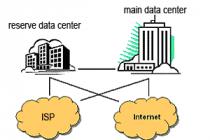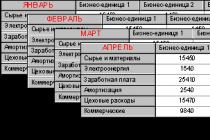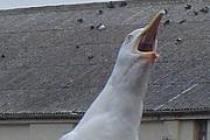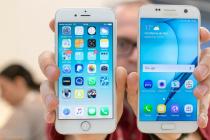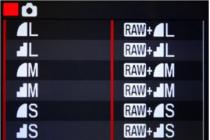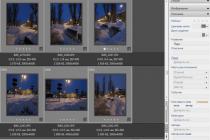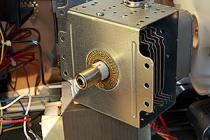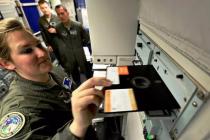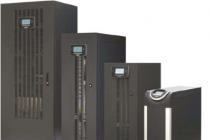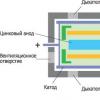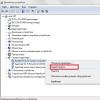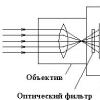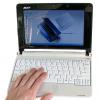Computing system concept
A specific set of interacting devices and programs designed to serve one working area is called computing system.
The set of devices designed for automatic or automated data processing is called computing technology or hardware... The composition of the computing system is called configuration... It is customary to consider hardware and software of a computing system separately.
The criteria for choosing a hardware and software solution is performance and efficiency.
The central device of a computing system is a computer. A computer Is an electronic device designed to automate the creation, storage, processing and transportation of data. Although hardware and software are considered separately, it should be noted that these computing system tools operate in an inextricable relationship and in continuous interaction.
The history of the development of computer technology. Generations of computers.
(Suggested for self-study students).
Computer classification
The massive use of PCs should not be obscured by the fact that in addition to PCs, there are many times more powerful computing systems:
· Supercomputers;
· Large computers (mainframes);
· Minicomputers;
· Microcomputers (these include personal PCs).
These computers are different:
· Productivity;
· Dimensions;
· Functional purpose.
Computer architecture and structure
When considering computer devices, it is customary to distinguish between their architecture and structure.
Architecture computer is called its description at some general level, including a description of user programming capabilities, command system, addressing system, memory organization, etc. The architecture defines the principles of operation, information links and the interconnection of the main logical nodes of the computer: processor, RAM, external storage and peripheral devices. The common architecture of different computers ensures their compatibility from the user's point of view.
Structure a computer is a collection of its functional elements and connections between them. Elements can be a wide variety of devices - from the main logical nodes of a computer to the simplest circuits. The structure of a computer is graphically represented in the form of structural diagrams, with the help of which it is possible to describe the computer at any level of detail.
Classical architecture(von Neumann architecture) - one arithmetic logic unit (ALU), through which the data stream passes, and one control unit (CU), through which the command stream passes - the program. it single processor computer... This type of architecture also includes the architecture of a personal computer with common bus... All functional blocks here are interconnected by a common bus, also called system backbone. Physically, the backbone is a multi-wire line with sockets for connecting electronic circuits. The collection of trunk wires is divided into separate groups: address bus, data bus and control bus.
There are many systems for classifying computers. We'll cover just a few of them, focusing on the ones that are most frequently mentioned in the available technical literature and the media.
Classification by purpose
Classification by purpose is one of the earliest classification methods. It has to do with how the computer is applied. According to this principle, large computers (electronic computers), mini-computers, micro-computers and personal computers are distinguished, which, in turn, are subdivided into mass, business, portable, entertainment and work stations.
The composition of a computing system is called a configuration. Computer hardware and software are usually considered separately. Accordingly, the hardware configuration of computing systems and their software configuration are considered separately. This principle of separation is of particular importance for informatics, since very often the solution of the same problems can be provided by both hardware and software. The criteria for choosing a hardware or software solution are performance and efficiency.
Where do you see the dialectical nature of the relationship between software and hardware?
What are the four main levels of software. What is the order of their interaction?
What class does the software built into a video recorder, programmable washing machine, microwave oven belong to?
What are the advantages and disadvantages of performing office work (eg copying and duplicating) with hardware and software?
What categories of software can be used by a small business and for what purposes?
What types of work, typical for a large industrial enterprise (for example, a machine-building plant), can be automated with
using computers? What are the categories of software tools for this
necessary?
What are the main categories of software related to the class of graphic editors? What is the fundamental difference between these categories?
What is common and what is the difference between the concepts of software and information support of computer technology?
When considering computers, it is customary to distinguish between their architecture and structure.

What characteristics of a computer are standardized to implement the principle of open architecture?
Only the description of the principle of operation of the computer and its configuration (a certain set of hardware and connections between them) are regulated and standardized. Thus, the computer can be assembled from individual assemblies and parts, designed and manufactured by independent manufacturers. The computer can be easily expanded and upgraded due to the presence of internal expansion slots, into which the user can insert a variety of devices, and, thereby, set the configuration of his machine in accordance with his personal preferences.
Indicate the distinctive features of classical architecture ("von Neumann")?
Von Neumann architecture. One arithmetic logic unit (ALU), through which the data stream passes, and one control unit (CU), through which the instruction stream passes - the program. This is a uniprocessor computer. This type of architecture includes the architecture of a personal computer with a common bus. All functional blocks are connected here with a common bus, also called a system bus.
Physically, the backbone is a multi-wire line with sockets for connecting electronic circuits. The collection of trunk wires is divided into separate groups: address bus, data bus and control bus.
Peripheral devices (printer, etc.) are connected to the computer hardware through special controllers - peripheral device control devices.
Controller- a device that connects peripheral equipment or communication channels with the central processor, freeing the processor from direct control of the operation of this equipment.
What are the advantages of standard and non-standard computer architectures?
Standard architectures address a wide variety of different tasks. At the same time, the speed advantage of multiprocessor and multicomputer systems over single-processor ones is obvious. When solving some specific problems, a non-standard architecture allows you to get high performance.
What are the most common areas of application of standard and non-standard computer architectures
1. Classical architecture. This is a uniprocessor computer. This type of architecture includes the architecture of a personal computer with a common bus. Peripheral devices (printer, etc.) are connected to the computer hardware through special controllers - peripheral device control devices.
2. Multiprocessor architecture. Having multiple processors in a computer means that many data streams and many instruction streams can be organized in parallel. Thus, several fragments of the same task can be executed in parallel.
3. Multi-machine computing system. Here, several processors included in the computing system do not have a common RAM, but each has its own (local) one. Each computer in a multi-machine system has a classical architecture, and such a system is widely used. The effect of using such a computing system can be obtained only when solving problems that have a very special structure: it must be broken down into as many loosely coupled subtasks as there are computers in the system. The speed advantage of multiprocessor and multi-machine computing systems over single-processor ones is obvious.
4. Architecture with parallel processors. Here several ALUs operate under the control of one CU. This means that a lot of data can be processed by one program - that is, one stream of instructions. High performance of such an architecture can be obtained only on tasks in which the same computational operations are performed simultaneously on different datasets of the same type. Modern machines often contain elements of various types of architectural solutions. There are also such architectural solutions that are radically different from those discussed above.
Point out the merits of open and closed computer architectures
Advantages of open architecture:
Competition between manufacturers has led to a reduction in the cost of computer components, and hence the computers themselves.
The emergence of a large number of computer equipment has allowed buyers to expand their choice, which also contributed to lower prices for components and an increase in their quality.
The modular structure of the computer and ease of assembly allowed users to independently choose the devices they need and easily install them, it also became possible to assemble and upgrade their computer without any special difficulties at home.
Upgradeability meant that users were able to choose a computer based on their real needs and pocket thickness, which again contributed to the increasing popularity of personal computers.
The advantage of a closed architecture:
The closed architecture does not allow other manufacturers to release additional external devices for computers, so there is no problem of compatibility between devices from different manufacturers.
Why are the hardware and software configuration of a computer considered separately?
Position 13 Basic hardware configuration of a personal computer
 |
|||
Self-help questions
Describe the functions of the processor. Indicate the main characteristics of the processor and their typical values.
Main processor functions:
Fetching (reading) executable commands;
Input (reading) data from memory or input / output device;
Output (write) data to memory or to input / output devices;
Data processing (operands), including arithmetic operations on them;
Memory addressing, that is, setting the memory address with which the exchange will be made;
Interrupt handling and direct access mode.
Processor specifications:
The number of bits of the data bus
The number of bits of its address bus
The number of control signals in the control bus.
The width of the data bus determines the speed of the system. The width of the address bus determines the allowable complexity of the system. The number of control lines determines the variety of exchange modes and the efficiency of the processor exchange with other system devices.
In addition to the pins for the signals of the three main buses, the processor always has a pin (or two pins) for connecting an external clock signal or a crystal resonator (CLK), since the processor is always a clocked device. The higher the clock speed of the processor, the faster it works, that is, the faster it executes commands. However, the speed of the processor is determined not only by the clock frequency, but also by the peculiarities of its structure. Modern processors execute most instructions in one clock cycle and have facilities for executing multiple instructions in parallel. The processor clock frequency is not directly and rigidly related to the trunk exchange rate, since the trunk exchange rate is limited by signal propagation delays and signal distortions on the trunk. That is, the clock frequency of the processor determines only its internal speed, and not external. Sometimes the processor clock speed has a lower and upper limit. If the upper frequency limit is exceeded, the processor may overheat, as well as malfunctions, and, what is most unpleasant, occurring not always and irregularly.
Initial reset signal RESET. When the power is turned on, in an emergency or when the processor freezes, this signal initializes the processor, forcing it to start executing the bootstrap program. An emergency situation can be caused by noise in the power and ground circuits, memory failures, external ionizing radiation and many more reasons. As a result, the processor can lose control over the program being executed and stop at some address. To exit this state, the initial reset signal is used. This initial reset input can also be used to alert the processor that the supply voltage has dropped below a specified limit. In this case, the processor proceeds to the program for saving important data. In fact, this input is a special kind of radial interrupt.
Sometimes the processor chip has one or two more radial interrupt inputs to handle special situations (for example, for an interrupt from an external timer).
The power bus of a modern processor usually has one supply voltage (+ 5V or + 3.3V) and a common wire ("ground"). Early processors often required multiple supply voltages. Some processors have a low power mode. In general, modern processor chips, especially those with high clock speeds, consume quite a lot of power. As a result, in order to maintain the normal operating temperature of the case, they often have to install radiators, fans or even special micro-refrigerators.
To connect the processor to the backbone, buffer chips are used to provide demultiplexing of signals and electrical buffering of the backbone signals, if necessary. Sometimes the exchange protocols on the system bus and on the processor buses do not coincide with each other, then the buffer microcircuits also coordinate these protocols with each other. Sometimes in a microprocessor system, several highways (system and local) are used, then a separate buffer node is used for each of the highways. This structure is typical, for example, for personal computers.
After power-up, the processor goes to the first address of the startup program and executes this program. This program is pre-recorded in non-volatile memory. After the end of the bootstrap program, the processor starts executing the main program located in permanent or random access memory, for which it selects all commands in turn. The processor can be distracted from this program by external interrupts or requests for DMA. The processor selects instructions from memory using read cycles along the line. If necessary, the processor writes data to memory or I / O devices using write cycles, or reads data from memory or from I / O devices using read cycles.
Indicate what is the basis for dividing computer memory into internal and external. Please list what is included in the internal memory?
The internal memory of a computer is designed to store programs and data with which the processor works directly while the computer is turned on. In modern computers, the elements of internal memory are made on microcircuits. The external memory of a computer is designed for long-term storage of large amounts of information. Turning off the power of the computer does not result in loss of data in the external memory. Internal memory includes RAM, cache and special memory.
Describe the functions of RAM. Indicate the main characteristics of random access memory and their typical values.
Random access memory - (RAM, English RAM, Random Access Memory - memory with random access) is a fast storage device of not very large volume, directly connected to the processor and designed to write, read and store executable programs and data processed by these programs.
RAM is used only for temporary storage of data and programs, because when the machine is turned off, everything that was in RAM is lost. Direct access to the elements of RAM - this means that each byte of memory has its own individual address.
The amount of RAM is usually 32 to 512 MB. For simple administrative tasks, 32 MB of RAM is sufficient, but complex computer design tasks can require 512 MB to 2 GB of RAM.
Typically, RAM is executed from SDRAM (Synchronous Dynamic RAM) memory integrated circuits. Each bit of information in SDRAM is stored in the form of an electrical charge from a tiny capacitor formed in the semiconductor crystal structure. Due to leakage currents, such capacitors are quickly discharged, and they are periodically (approximately every 2 milliseconds) recharged by special devices. This process is called Refresh Memory. SDRAM chips have a capacity of 16 - 256 Mbit or more. They are installed in housings and assembled into memory modules.
What is the purpose of external memory? List the types of external memory devices.
External memory (OVC) is designed for long-term storage of programs and data, and the integrity of its contents does not depend on whether the computer is turned on or off. Unlike RAM, external memory has no direct connection to the processor.
The external memory of the computer includes:
Hard disk drives;
Floppy disk drives;
Compact disc drives;
Magneto-optical compact disks;
Tape drives (streamers), etc.
Describe how the hard drive works. Indicate the main characteristics of the hard disk and their typical values.
Hard Disk Drive - (English HDD - Hard Disk Drive) or hard drive- this is the most mass storage device of large capacity, in which information carriers are round aluminum plates - platter, both surfaces of which are covered with a layer of magnetic material. Used for permanent storage of information - programs and data.
Like a floppy disk, plotters' work surfaces are divided into circular concentric tracks, and the tracks are divided into sectors. The read / write heads, together with their carrier structure and disks, are enclosed in a hermetically sealed enclosure called a data module. When a data module is inserted into the drive, it automatically connects to the system that supplies cleaned, cooled air. The surface of the plotter is magnetically coated with a thickness of only 1.1 microns, as well as a layer of grease to protect the head from damage when lowering and lifting on the go. As the plotter rotates, an air layer forms above it, which provides an air cushion for the head to hang at a height of 0.5 microns above the disk surface.
Winchester drives have a very large capacity: from 10 to 100 GB. In modern models, the spindle (rotating shaft) rotation speed is usually 7200 rpm, the average data retrieval time is 9 ms, the average data transfer rate is up to 60 MB / s. Unlike a floppy disk, a hard disk spins continuously. All modern drives are equipped with a built-in cache (usually 2 MB), which significantly improves their performance. The Winchester drive is connected to the processor through the hard disk controller.
What are device ports? Describe the main types of ports.
Relatively recently, the term "computer technology" has appeared in everyday life. This designation initially did not completely imply all those aspects that are invested in it today. And, unfortunately, for some reason most people think that computers and computing are synonymous words. This is a clear delusion.
Computing: the meaning of the word
The meaning of this term can be interpreted in completely different ways, especially since different dictionaries can interpret it in different interpretations.
However, if we approach the issue as if with some generalization, we can safely say that computing technology is a technical device with a set of some mathematical means, techniques and methods for automating (or even mechanizing) the processing of any information and computation processes or description of one or more another phenomenon (physical, mechanical, etc.).
what is this in a broad sense?
Computing technology has been known to mankind for a long time. The most primitive devices that appeared hundreds of years before our era can be called, for example, the same Chinese abacus or the Roman abacus. Already in the second half of this millennium, devices such as the Knepper scale, Schickard's adding machine, calculating machine, etc. appeared. Judge for yourself, today's analogs in the form of calculators can also be safely attributed to one of the varieties of computer technology.

Nevertheless, the interpretation of this term acquired a more extended meaning with the advent of the first computers. It happened in 1946, when the first computer was created in the USA, designated by the abbreviation ENIAC (in the USSR, such a device was created in 1950 and was called MESM).
To date, the interpretation has expanded even more. Thus, at the present stage of technology development, it can be determined that computer technology is:
- computer systems and network management tools;
- automated control systems and data processing (information);
- automated design, modeling and forecasting tools;
- software development systems, etc.
Computing tools
Now let's see what computer technology is. Any process is based on information or, as they say now, data. But the concept of information is considered quite subjective, since for one person a process can carry a semantic load, but for another it does not. Thus, for the unification of data, it was developed which is perceived by any machine and is used for data processing most widely.

Among the tools themselves, one can single out technical devices (processors, memory, input / output devices) and software, without which all this "hardware" is completely useless. It should be noted separately here that a computing system has a number of characteristic features, for example, integrity, organization, coherence and interactivity. There are also so-called computing systems, which are referred to as multiprocessor systems that provide reliability and increased performance levels that are inaccessible to conventional uniprocessor systems. And only in a common bundle of "hardware" and software can we say that they are the main means of computing. Naturally, you can add here the methods by which the mathematical description of a process is made, but this can take quite a long time.
The device of modern computers
Based on all these definitions, it is possible to describe the operation of modern computers. As mentioned above, they combine hardware and software, and one cannot function without the other.
Thus, a modern computer (computing technology) is a set of technical devices that ensure the functioning of a software environment for performing certain tasks, and vice versa (a set of programs for the operation of "hardware"). The first statement is the most correct, and not the second, because in the end this set is needed precisely for processing incoming information and outputting the result.

(computing) includes several main components, without which no system can do. This includes motherboards, processors, hard disks, RAM, monitors, keyboards, mice, peripherals (printers, scanners, etc.), floppy drives, etc. In terms of software, operating systems and drivers take the first place. Operating systems run application programs, and drivers ensure the correct functioning of all hardware devices.
A few words about classification
Modern computing systems can be classified according to several criteria:
- principle of operation (digital, analog, hybrid);
- generations (stages of creation);
- purpose (problem-oriented, basic, household, dedicated, specialized, universal);
- capabilities and sizes (super large, super small, single or multiplayer);
- conditions of use (home, office, industrial);
- other signs (number of processors, architecture, performance, consumer properties).
As it is already clear, it is impossible to draw clear boundaries in the definition of classes. In principle, any division of modern systems into groups still looks purely arbitrary.
Computing system composition. Composition of the computing system Consider the hardware and software configurations. Interfaces of any computing system can be conditionally divided into serial and parallel. The system level is a transitional one that ensures the interaction of other programs of a computer system both with programs of the basic level and directly with the hardware, in particular with the central processor.
Share your work on social media
If this work did not suit you at the bottom of the page there is a list of similar works. You can also use the search button
Lecture 4. The history of the development of computer technology. Classification of computers. Computing system composition. Hardware and software. Classification of utility and application software
The history of the development of computing technology
The first calculating devices were mechanical devices. In 1642 a French mechanic Blaise Pascal developed a compact summing device - mechanical calculator.
In 1673 German mathematician and philosopher Leibniz improved it by addingmultiplication and division operations... Over the course of the 18th century, more and more advanced, but still mechanical computing devices based on gear, rack and pinion, lever and other mechanisms were developed.
The idea of programming computational operations came from hourly industry. Such programming was tough: the same operation was performed at the same time (for example, the work of a machine on a copier).
The idea of flexible programmingcomputational operations was expressed by an English mathematicianCharles Babbage in 1836-1848 A feature of his analytical engine was the principle of dividing information intocommands and data... However, the project was never implemented.
Computing programs on Babbage's machine, compiled by the daughter of the poet Byron Adoy Lovelace (1815-1852), are very similar to the programs compiled later for the first computers. This wonderful woman was namedthe first programmer in the world.
When switching from registration mode provisions mechanical device to the mode registration states of electronic device elementsdecimal system becameinconvenient, since the states of the elements are only two : on and off.
Possibility to represent anynumbers in binary formwas first expressed by Leibniz in 1666.
The idea behind encoding logical statements into mathematical expressions:
- true (True) or false (False);
- in binary code 0 or 1,
was implemented by the English mathematician George Boole (1815-1864) in the first half XIX century.
However, the Boolean algebra of logic developed by him found application only in the next century, when a mathematical apparatus was needed to design computer circuits using the binary number system. The American scientist Claude Shannon "connected" mathematical logic with the binary number system and electrical circuits in his famous dissertation (1936).
In logical algebra, when creating computers, they are used in basically 4 operations:
- AND (intersection or conjunction - A^ B);
- OR (union or disjunction - AvB);
- NOT (inversion - | A);
- EXCLUSIVE OR ( A * | B + | A * B).
In 1936 the English mathematician A. Turing and, independently of him E. Post, put forward and developed the concept ofabstract computing machine... They proved the fundamental possibility of solving any problem by automata, provided that it is possible to algorithmize it.
In 1946, a report was drawn up by John von Neumann, Goldstein and Burks (Princeton Institute for Advanced Study), which contained a detailed description ofprinciples of building digital computersthat are still in use today.
- The architecture of John von Neumann's computers includes:
- CPUconsisting of a control unit (CU) and an arithmetic logic unit (ALU);
- memory : operational (RAM) and external;
- Input Devices;
- output devices.
- The principles of the computer, proposed by von Neumann:
- uniformity of memory;
- program control;
- targeting.
- The main generations of computers and their characteristics can be distinguished:
|
Years |
1955-60 |
1960 - 65 |
1965 - 70 |
1970 - 90 |
1990 to |
|
Basic |
Electronic |
Transistor |
IP |
Big |
Big |
|
Computer example |
IBM 701 |
IBM 360-40 |
IBM 370- |
IBM 370-168 |
IBM Server |
|
Fast-paced |
8 000 |
246 000 |
1 230 000 |
7 700 000 |
9*10 9 |
|
RAM capacity, |
20 480 |
256 000 |
512 000 |
8 200 000 |
256*10 9 |
|
Note |
Shannon, |
Languages |
Minicom- |
PC, |
Artificial |
The rapid development of computing systems began in the 60s of the 20th century with the rejection ofelectronic tubes and development semiconductor, and then laser technology.
Efficiency Computers (computers) grew significantly in the 70s of the 20th century with the development of processors based onintegrated circuits.
A quantum leap in the development of computers took place in the 80s Xx century with the invention personal computer and the development of a worldwide information network - the Internet.
Computer classification
- By appointment:
- supercomputers;
- servers;
- embedded computers (microprocessors);
- personal computers (PC).
Supercomputers - computing centers - are created to solve extremely complex computational problems (modeling complex phenomena, processing extremely large amounts of information, making forecasts, etc.).
Servers (from the English word serve to serve, manage) are computers that ensure the operation of a local or global network, specializing in the provision of information services and maintenance of computers of large enterprises, banks, educational institutions, etc.
Embedded computers (microprocessors) have become widespread in manufacturing and household appliances, where control can be reduced to the execution of a limited sequence of commands (robots on a conveyor belt, onboard robots integrated into household appliances, etc.)
Personal computers ( PC ) are designed to be used by one person, therefore they are used everywhere. They were born on August 12, 1981, when IBM introduced their first model. PCs have made a computer revolution in the lives of millions of people and have had a huge impact on the development of human society.
PC are divided into mass, business, portable, entertainment, and workstations.
PC standards:
- Consumer PC (mainstream)
- Office PC (business);
- Entertainment PC (entertainment);
- Workstation PC (workstation);
- Mobile PC (portable).
Most PCs are mass-produced.
Business (office) PC contain professional programs, but they minimize the requirements for graphics and audio playback tools.
In entertainment PC funds are widely represented Multimedia.
Workstations have increased data storage requirements.
For portable devices, it is mandatory to have access to a computer network.
- By the level of specialization:
- universal;
- specialized (examples: file server, Web -server, print server, etc.).
- By standard sizes:
- desktop (desktop);
- wearable (notebook, iPad);
- pocket (palmtop);
- mobile computing devices (PDA - p ersonal d igital a ssist a nt) that combine the functions of palmtop and cell phones.
- Hardware compatibility:
- IBM PC;
- Apple Macintosh.
- By processor type:
- Intel (in personal computers from IBM);
- Motorola (Macintosh personal computers).
Computing system composition
Consider the hardware and software configuration, since often the solution to the same problems can be provided by both hardware and software. The criterion in each case is work efficiency.
It is believed that increasing the efficiency of work due to the development of hardware is on average more expensive, but the implementation of solutions by software requires highly qualified personnel.
Hardware
To the hardware providing computing systems includedevices and devices(block-modular design is used).
Internal and external devices are distinguished by the way the devices are placed relative to the central processing unit. External devices are input-output devices (peripheral devices) and additional devices designed for long-term data storage.
Coordination between individual blocks and nodes is carried out using transitional hardware-logical devices - hardware interfaces operating in accordance with approved standards.
Interfaces of any computing system can be roughly divided intoserial and parallel.
Parallel interfaces are more complex, require synchronization of the transmitting and receiving devices, but have higher performance, which is measuredbytes per second(byte / s, KB / s, MB / s). Used (now rarely) when connecting a printer.
Consecutive - easier and slower, they are calledasynchronous interfaces... Due to the lack of synchronization of the parcels, the payload data is preceded and terminated by service data packets (1 byte - 1-3 service bits), the performance is measuredbits per second(bit / s, kbps, Mbps).
They are used to connect input, output and information storage devices of a mouse, keyboard, flash memory, sensors, voice recorders, video cameras, communication devices, printers, etc.
Standards on hardware interfaces in VT are called protocols. A protocol is a set of technical conditions that must be provided by computer developers in order to successfully coordinate the operation of devices.
Software
Software (software) or software configuration are programs (ordered sequences of commands). There is a relationship between programs: some work relying on others (of a lower level), that is, we should talk about an interprogram interface.
- Basic level (BIOS) - the lowest level. The underlying hardware is responsible for interacting with the underlying hardware. Basic software is stored on a microcircuit permanent storage device - ROM (Read Only Memory (ROM)).
If the parameters of the basic tools need to be changed during operation, applyreprogrammable Erasable and Programmable Read Only Memory (EPROM ). The implementation of the EPROM is carried out using a "non-volatile memory" microcircuit or CMOS which also works when the computer boots up.
- System level- transitional, ensuring the interaction of other programs of the computer system, both with the programs of the basic level, and directly with the hardware, in particular with the central processor.
The system support includes:
- device drivers- programs that ensure the interaction of a computer with specific devices;
- installation tools programs;
- standard user interface tools,ensuring effective interaction with the user, entering data into the system and obtaining the result.
The set of system-level programs formsoperating system kernel PC.
If the computer is equipped with system-level software, then it is already prepared:
- to the interaction of software with equipment;
- to the installation of programs of higher levels;
- and most importantly, user interaction.
mandatory and mostly sufficient condition to ensure work person on the computer.
- Service levelsoftware makes it possible to work with both basic-level programs and system-level programs. The main purpose of the service programs (utilities) is to automate the work on checking, adjusting and configuring the PC. In addition, they are used to expand and improve the functions of system programs. Some of the service-level programs are included as standard with the operating system.
There are two alternative directions in the development and operation of utility programs: integration with the operating system and autonomous operation.
In the second case, they provide the user with more options for personalizing their interaction with hardware and software.
- Application levelis a complex of applied programs with the help of which specific tasks are performed at a given workplace. Their range is very wide (from production to entertainment).
Availability of application software and breadth of functionality PC directly depends on the operating system used, that is, what system tools its core contains and, therefore, how it provides interaction: a person - programs - equipment.
Utility software classification
- File managers(file managers). They can be used to copy, move and rename files, create directories, delete files and directories, search for files and navigate the file structure (for example, Explorer ( Windows Explorer)).
- Archivers - file compression tools
- Viewers and playback tools... Simple and versatile viewers that do not provide editing, but allow you to view (reproduce) documents of different types.
- Diagnostic tools- to automate the diagnostic processes of software and hardware. Used not only for troubleshooting, but also to optimize the performance of your computer.
- Controls (monitoring) or monitors - allow you to monitor the processes occurring in the computer. Two modes are used: monitoring in real time and monitoring with recording the results in a protocol file (used when monitoring must be provided automatically and remotely).
- Installation monitors- provide control of software installation, monitor the state of the surrounding software environment, allow you to restore connections lost as a result of removing previously installed programs.
The simplest monitors are usually part of the operating system and are located at the system level.
- Means of communication(communication programs) - connections to remote computers, service the transmission of e-mail messages, etc.
- Computer security tools(active and passive). Passive protections are backup programs. Antivirus software is used as active protection means.
- Means of electronic digital signature(EDS).
Classification of application programs
- Text editors(Notepad, WordPad , Lexicon, editor Norton Commander, etc.).
- Word processors(they allow not only to enter and edit texts, but also to format, that is, to arrange them). Thus, the means of ensuring interaction are among the means of word processors. text, graphics , tables, as well as tools for automating the formatting process (Word).
- Graphic editor... These are raster (dot), vector editors and creation tools three-dimensional graphics (3D editors).
In raster editors ( Paint ) a graphic object is represented as a combination of points, each of which has properties of brightness and color. This option is effective in cases where the image has many halftones, and information about the color of the object's elements is more important than information about their shape. Bitmap editors are widely used for image retouching, creating photo effects, but they are not always convenient for creating new images and are uneconomical, because images have a lot of redundancy.
In vector editors ( CorelDraw ) the elementary object of the image is not a point, but a line. This approach is typical for drawing and graphic works, when the shape of the lines is more important than information about the color of individual points that make up it. This view is much more compact than the raster view. Vector editors are convenient for creating images, but they are practically not used for processing finished drawings.
Three-dimensional graphics editors allow you to flexibly control the interaction of object surface properties with the properties of light sources, as well as create three-dimensional animation, which is why they are also called 3 D-animators.
- Database management systems(DBMS). Their main functions are:
- creating an empty database;
- providing means for filling it in and importing data from tables of another database;
- providing the ability to access data, search and filter tools.
- Spreadsheets... These are complex tools for storing and processing data ( Excel ). Provides a wide variety of methods for working with numeric data.
- Computer-aided design systems(CAD systems). Designed to automate design work, and can also perform elementary calculations and the selection of structural elements from databases.
- Desktop publishing systems... Designed to automate the process of layout of printed publications. They occupy an intermediate position between word processors and computer-aided design systems. Typical use is applied to documents that have been preprocessed in word processors and graphics editors.
- Expert systems(analysis of data contained in knowledge bases). Their characteristic feature is the ability for self-development (if necessary, it generates a sufficient set of questions to an expert and automatically improve its quality).
- WEB - editors ... Combine properties of text and graphic editors and are intended for creation and editing WEB - documents.
- Browsers (viewers WEB - documents).
- Integrated office systems.The main functions are editing and formatting of the simplest documents, centralization of e-mail, fax and telephone communications, dispatching and monitoring of enterprise documents.
- Accounting systems - combine the functions of text and spreadsheet editors, provide automation of preparation and accounting of primary documents, maintaining accounts of an accounting plan, preparation of regular reporting.
- Financial analyticalsystems. They are used in banking and exchange structures. They allow you to monitor and predict the situation in the financial, stock and commodity markets, analyze, prepare reports.
- Geoinformationsystems (GIS). Designed to automate cartographic and geodetic works.
- Video editing systems- video processing.
- Educational, developmental, reference and entertainmentprograms. Their peculiarity is the increased requirements for multimedia facilities (musical compositions, graphic animation and video materials).
In addition to hardware and software, there areInformation Support(spell checker, dictionaries, thesauri, etc.)
In specialized computer systems (onboard), the set of software and information support is called mathematical software.
PAGE 7
Other similar works that may interest you. Wshm> |
|||
| 7644. | Formation of ideas about methods of solving applied problems using computer technology | 29.54 KB | |
| The presence of an error is due to a number of reasons. Initial data usually contain errors because they are either obtained as a result of measurement experiments or are the result of solving some auxiliary problems. The total error of the result of solving the problem on a computer consists of three components: the fatal error of the error of the method and the computational error:. | |||
| 166. | Providing grounding in computing | 169.06 KB | |
| Almost every power supply unit for a computer or other device has a surge protector fig. When zeroing, you need to be sure that this zero will not become a phase if someone turns over any power plug. Input circuits of the computer power supply Fig. Formation of potential on the computer case Of course, the power of this source is limited by a short-circuit current to earth, ranging from units to tens of milliamperes, and the more powerful the power supply, the usually greater the capacitance of the filter capacitors and therefore the current: ... | |||
| 167. | General information on the operation of computer technology | 18.21 KB | |
| Basic concepts Computer facilities SVT are computers, which include personal computers, personal computers, network workstations, servers and other types of computers, as well as peripheral devices, computer office equipment and intercomputer communication facilities. Operation of SVT consists in using the equipment for its intended purpose when the VT must perform the whole range of tasks assigned to it. For effective use and maintenance of SVT in a working condition during operation, it is carried out ... | |||
| 8370. | Setting up folders and files. Setting up operating system tools. Application of standard utilities. The principles of linking and embedding objects. Networks: basic concepts and classification | 33.34 KB | |
| Setting up operating system tools. Configuring the operating system tools All settings are carried out as a rule through the Control Panel. Setting up the operating system style Setting up the system style is carried out along the path: Start - Control Panel - All elements of the control panel - System. The Advanced system settings tab opens the System Properties window in which the Advanced tab is the most important for configuration. | |||
| 9083. | Software. Purpose and classification | 71.79 KB | |
| Antiviruses Oddly enough, there is still no precise definition of what a virus is. either inherent in other programs that are in no way viruses, or there are viruses that do not contain the above distinctive features, except for the possibility of spreading. macro viruses infect Word and Excel document files. There are a large number of combinations, such as file boot viruses, infecting both files and boot sectors of disks. | |||
| 5380. | Development of an educational stand Design and principle of operation of a printer as a means of improving the quality of training students in the specialty Maintenance of computer technology and computer networks | 243.46 KB | |
| Printers are classified according to five main positions: the principle of the printing mechanism, the maximum paper size, the use of color printing, the presence or absence of hardware support for the PostScript language, as well as the recommended monthly load. | |||
| 10480. | Computer software. Types of application programs | 15.53 KB | |
| By changing the programs for the computer, you can turn it into the workplace of an accountant or a constructor, a statistician or a designer, edit documents on it or play some game. Classification of programs Programs running on a computer can be divided into three categories: application programs directly ensuring the performance of the work necessary for users: editing texts, drawing pictures, watching videos, etc .; system programs that perform various auxiliary functions such as making copies ... | |||
| 7045. | Information Systems. Concept, composition, structure, classification, generation | 12.11 KB | |
| Properties of the information system: Severability allocation of subsystems that simplifies the analysis, development, implementation and operation of IS; Integrity consistency of functioning of subsystems of the system as a whole. The composition of the information system: Information environment is a set of systematized and organized in a special way data and knowledge; Information Technology. Classification of IS by purpose Information - control - systems for collecting and processing information necessary for managing an enterprise organization ... | |||
| 19330. | DEVELOPMENT OF A TRANSPORT LOGISTICS COMPUTER SYSTEM IN C # LANGUAGE | 476.65 KB | |
| A programming language is a formal sign system for writing computer programs. A programming language defines a set of lexical, syntactic and semantic rules that determine the appearance of the program and the actions that the executor (computer) will perform under its control. | |||
| 9186. | The process of a computing system and related concepts | 112.98 KB | |
| Consider the following example. Two students run the square root program. One wants to calculate the square root of 4, and the other wants to calculate the square root of 1. From the students' point of view, the same program is running; from the point of view of a computer system, it has to deal with two different computational processes, since different input data lead to a different set of calculations. | |||

